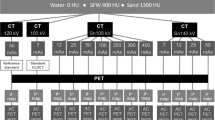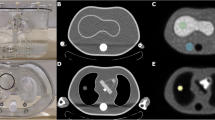Abstract
Purpose
Thallous (201Tl) chloride is a single-photon emission computed tomography (SPECT) tracer mainly used for assessing perfusion and viability of myocardial tissue. 201Tl emits X-rays around 72 keV and gammas at 167 keV, and has a half-life of 73 h. Regulations allow an intrinsic contamination up to 3-5%, which is mainly caused by 200Tl (368 keV; 26 h) and by 202Tl (439 keV; 12.2 days). Contra-intuitive to the low-level percentages in which these contaminants are present, their impact may be significant because of much higher gamma camera sensitivity for these high-energy photon emissions. Therefore, we investigate the effects of the contaminants in terms of detected fractions of photons in projections and contrast degradation in reconstructed images.
Methods
Acquisitions of a digital thorax phantom filled with thallous (201Tl) chloride were simulated with a validated Monte Carlo tool, thereby, modelling 1% of contamination by 200Tl and 202Tl each. In addition, measurements of a thorax phantom on a dual-headed gamma camera were performed. The product used was contaminated by 0.17% of 200Tl and 0.24% of 202Tl at activity reference time (ART). This ART is specified by the manufacturer, thereby, accounting for the difference in half-lives of 201Tl and its contaminants. These measurements were repeated at different dates associated with various contamination levels.
Results
Simulations showed that, with 1% of 200Tl and 202Tl, the total contamination in the 72 keV window can rise up to one out of three detected photons. For the 167keV window, the contamination is even more pronounced: more than four out of five detections in this photopeak window originate from contaminants. Measurements indicate that cold lesion contrast in myocardial perfusion SPECT imaging is at maximum close to ART. In addition to a higher noise level, relative contrast decreases 15% 2 days early to ART, which is explained by an increase in 200Tl contamination. After ART, contrast decreased by 16% when the 202Tl contamination increased to the maximal allowed limit.
Conclusions
Contra-intuitive to the low-level percentages in which they are typically present, penetration and downscatter of high-energy photons from 200Tl and 202Tl significantly contribute to thallous (201Tl) chloride images, thereby, reducing contrast and adding noise. These findings may prompt for improved production methods, for updated policies with regard to timing of usage, and they also render the usefulness of adding the high photopeak window (167 keV) questionable. A window-based correction method for this contamination is advisable.











Similar content being viewed by others
References
Travin M, Bergmann S. Assessment of myocardial viability. Semin Nucl Med. 2005;35(1):2-16.
Germano G, Erel J, Kiat H, Kavanagh P, Berman D. Quantitative LVEF and qualitative regional function from gated 201Tl perfusion SPECT. J Nucl Med. 1997;38(5):749-54.
Kelion A, Anagnostopoulos C, Harbinson M, Underwood S, Metcalfe M, British Nuclear Cardiology Society. Myocardial perfusion scintigraphy in the UK: insights from the British Nuclear Cardiology Society Survey 2000. Heart 2005;91(Suppl IV):2-5.
Gaim S, Weinrich R, Ollig H. Production of 201Tl and 203Pb via proton induced nuclear reactions on nuclear thallium. Appl Radiat Isotopes. 1978;30:85-95.
Bonardi M, Groppi F, Birattari C. A rapid improved method for gamma-spectrometric determination of 202Tl impurities in [201Tl]-labelled radiopharmaceuticals. Appl Radiat Isotopes. 2002;57:647-55.
United States Pharmacopoeial Convention. Thallous chloride injection. United States Pharmacopeia 2006;29:2108.
Europena Directorate for the Quality of Medicines. Thallous [201Tl] chloride injection. European Pharmacopeia 2005;1:867.
British Pharmacopeia Commission. Thallous [201Tl] chloride injection. British Pharmacopeia 2005;3:3088.
Thomas S, Stabin M, Castronovo F. Radiation-absorbed dose from 201Tl-thallous chloride. J Nucl Med. 2005;46(3):502-8.
Bergamini C, Marengo M, Laudicina L, Mazzotti G, Dondi M. Estimation of radiation dose produced by impurities in nuclear medicine studies using 201Tl chloride. La Radiologia medica (Torino). 1986;72(9):656-9.
Blachardon E, Challeton-de Vathaire C, Boisson P, Martin J-C, Cassot G, Herbelet G, et al. Long term retention and excretion of 201Tl in a patient after myocardial perfusion imaging. Radiat Prot Dosim. 2005;113(1):47-53.
Stabin M, Brill B. Physics applications in nuclear medicine: organization and progress. J Nucl Med. 2006;47:22N-7N.
Groch M, Lewis G. 201Tl: scintillation camera imaging considerations. J Nucl Med. 1975;17(2):142-5.
Saegusa K, Fukushi M, Katoh Y, Saitoh H, Irifune T. Gamma-ray spectra of 201Tl-radiopharmaceuticals with a scintillation camera—crosstalk of contaminating nuclides of 200Tl and/or 202Tl onto 201Tl-photopeaks. Radioisotopes. 1990;39(6):255-60.
Agnostelli S, Allison J, Amako K, et al. Geant4: a simulation toolkit. Nucl Instrum Methods A. 2003;506:250-303.
Bielajew A, Hirayama H, Nelson W, Rogers D. History, overview and recent improvements of EGS4 Tech. Rep. Ottawa, Canada: National Research Council; 1994.
Briesmeister J. MCNP—a general Monte Carlo N-particle transport code. Tech. Rep. Los Alamos National Laboratory, Los Alamos, NM, USA. 1993.
Jan S, Santin G, Strul D, et al. GATE: a simulation toolkit for PET and SPECT. Phys Med Biol. 2004;49:4543-61.
Assié K, Gardin I, Vera P, Buvat I. Validation of the Monte Carlo simulator GATE for 111In imaging. Phys Med Biol. 2005;50:3113-25.
Lazaro D, Buvat I, Loudos G, et al. Validation of the GATE Monte Carlo simulation platform for modelling a CsI(Tl) scintillation camera dedicated to small-animal imaging. Phys Med Biol. 2004;49:271-85.
Staelens S, Strul D, Santin G, et al. Monte Carlo simulations of a scintillation camera using GATE: validation and application modelling. Phys Med Biol. 2003;48:3021-42.
Tsui B, Zhao X, Gregoriou G, Lalushl D, Frey E, Johnston R, et al. Quantitative cardiac SPECT reconstruction with reduced image degradation due to patient anatomy. IEEE Trans Nucl Sci. 1994;41:2838-44.
LaCroix K, Tsui B, Hasegawa B. A comparison of 180 degrees and 360 degrees acquisition for attenuation-compensated 201Tl SPECT images. J Nucl Med. 1998;39(3):562-74.
Kadrmas D, Frey E, Tsui B. Simultaneous 99mTc/201Tl SPECT imaging with model-based compensation for cross-contaminating effects. Phys Med Biol. 1999;44(7):1843-60.
Gagnon D, Tung C, Zeng L, Hawkins W. Design and early testing of a new medium-energy transmission device for attenuation correction in SPECT and PET. Proc. IEEE Med Imaging Conf. 1999;3:1349-53.
Germano G, Kavanagh P, Waechter P, et al. A new algorithm for the quantitation of myocardial perfusion SPECT: technical principles and reproducibility. J Nucl Med. 2000;41:712-9.
de Puey E, Garcia E, Berman D. Cardiac SPECT imaging. 2nd ed. Philadelphia, PA: Lippincott Williams and Wilkins; 2001.
Dobbeleir A, Hambye A-S, Franken P. Influence of high-energy photons on the spectrum of 123I with low and medium-energy collimators: consequences for imaging with 123I labelled compounds in clinical practice. Eur J Nucl Med Mol I. 1999;26:655-8.
Staelens S, de Wit T, Beekman F. Ultra-fast SPECT simulation with combined convolution based forced detection and efficient septal penetration modeling [abstract]. J Nucl Med. 2006;47(Suppl):198P.
Staelens S, de Wit T, Beekman F. Fast hybrid SPECT simulation including efficient septal penetration modelling (SP-PSF). Phys Med Biol. 2007;52:3027-43.
Acknowledgment
The authors thank Geert Ensing and Mark Konijnenberg (Tyco Healthcare/Mallinckrodt) Leonie Rijks (GE Healthcare) and Pascal Bartkowiak (Schering) for providing details on their production of thallous (201Tl) chloride. The work of S.S. is supported by the Fund for Scientific Research, Flanders (FWO). The work of T.D.W. is supported by the Dutch Science and Technology Foundation (STW) by grant UGT.6069. The work of I.L. is supported by Ghent University, and the work of F.B. is supported by the Medical Counsel of the Dutch Organization for Scientific Research by grant 917.36.335. The contents are solely the responsibility of the authors and do not necessarily represent the official view of the sponsoring agencies.
Author information
Authors and Affiliations
Corresponding author
Rights and permissions
About this article
Cite this article
Staelens, S.G., de Wit, T.C., Lemahieu, I.A. et al. Degradation of myocardial perfusion SPECT images caused by contaminants in thallous (201Tl) chloride. Eur J Nucl Med Mol Imaging 35, 922–932 (2008). https://doi.org/10.1007/s00259-008-0719-z
Received:
Accepted:
Published:
Issue Date:
DOI: https://doi.org/10.1007/s00259-008-0719-z




